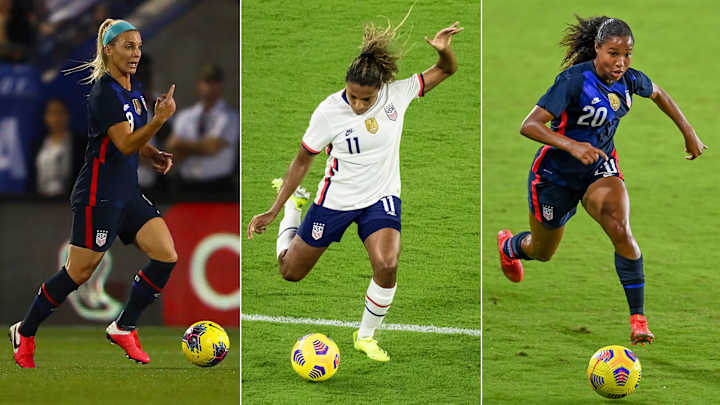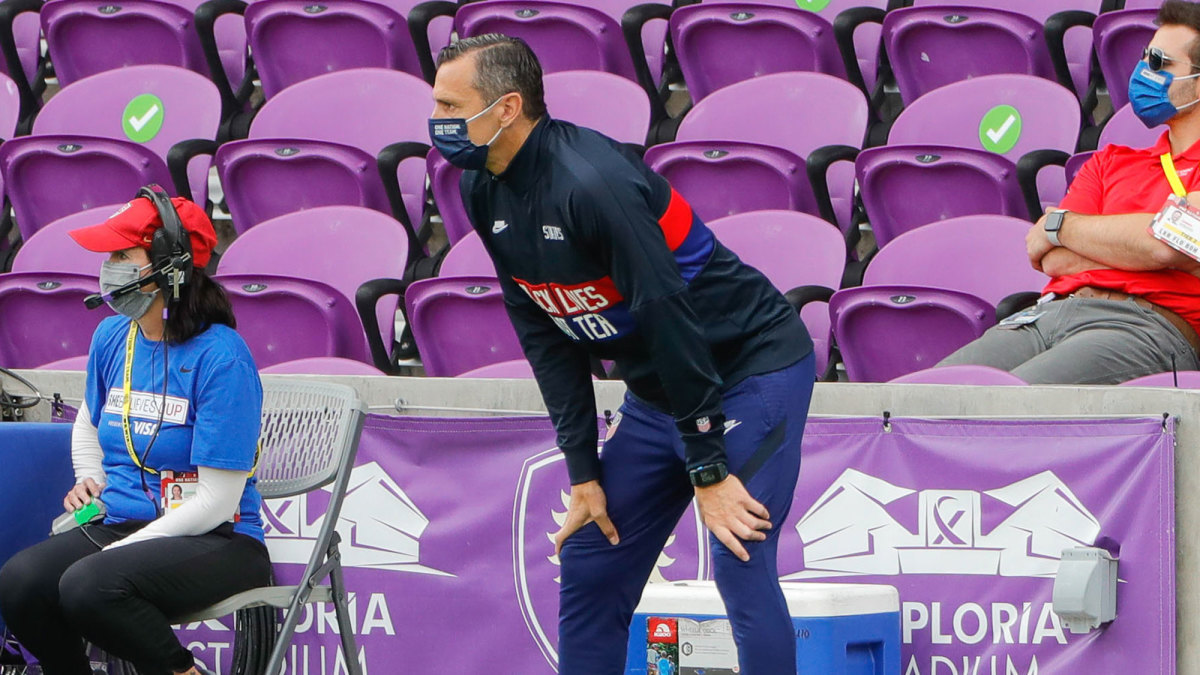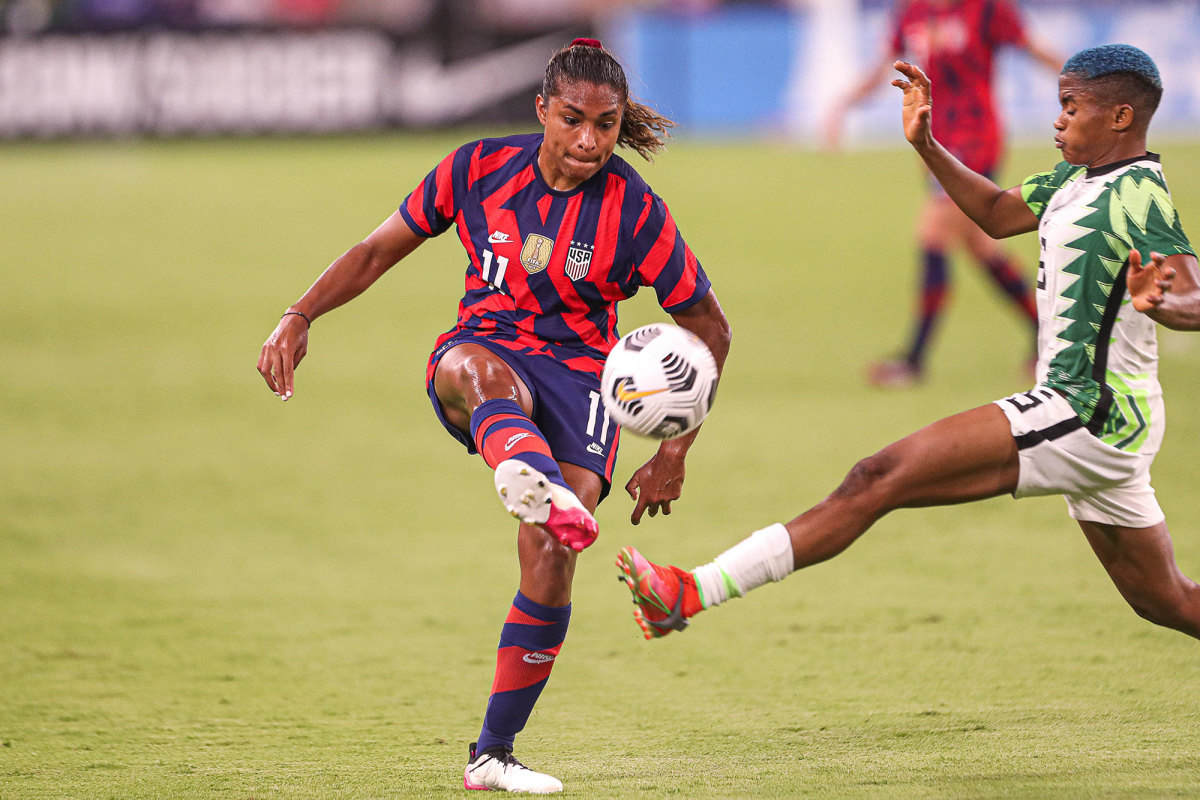The USWNT's Lingering Olympic Roster Questions

Decision time is here for Vlatko Andonovski and his staff.
The USWNT beat Nigeria 2–0 in a friendly Wednesday night, wrapping up a three-game summer series in Texas that was meant to simulate the condensed format of next month’s Olympic schedule and the heat and humidity of host nation Japan. After three wins (over Portugal, Jamaica and Nigeria), it’s time to answer the question that’s buzzed around Andonovski ever since he took over for Jill Ellis back in October 2019.
Who will make the Olympic roster?
Olympic soccer teams are notoriously small, with only 18 players at a coach’s disposal plus four alternates who travel to the host country but are not eligible to suit up unless someone permanently withdraws due to injury or illness. Compare that to a 23-player Women’s World Cup roster, 18 of which can make any given gameday roster.
There are plenty of shoo-ins who are certain to hear their names called when Andonovski announces his 18-player squad, and his first-choice starting XI seems fairly obvious right now. But the final roster spots can be just as important, especially with a smaller group and the prospect of playing as many as six games in 17 days. And those final roster spots—as well as a couple of significant injury situations—are exactly where the intrigue lies while we await official news.
Here are five key questions around the pending U.S. roster reveal:

Will Heath and Ertz be healthy?
Of perhaps primary importance to Andonovski over the next month is the status of two of his stars: forward Tobin Heath and midfielder Julie Ertz. The 33-year-old Heath is one of the most creative and dangerous wingers in the game and is already a two-time Olympian, while the 29-year-old Ertz is an indispensable defensive midfielder and ball-winner who is rarely on the sideline. But that’s exactly where Ertz finds herself at the moment after sustaining a right knee MCL sprain during the Chicago Red Stars’ NWSL opener in mid-May. Heath, meanwhile, has not played since December after injuring her ankle while with Manchester United in January and then picking up a knee injury during recovery.
The pair sat out of the June summer series, with Andonovski telling the media that “Tobin is a little bit ahead of Julie in her progression” but that both are anticipated to be ready for the Olympics. Indeed, Heath served as a training player during the camp, and on Tuesday, the manager said the forward is “not 100% included in everything that we do but we include her as much as possible.”
While those are encouraging words, there is only a little over a month until the team’s July 21 Olympic opener vs. Sweden. Any further setback to either could be devastating and could force Andonovski to make a tough decision. And while Ertz has played for the majority of 2021 so far, there’s the matter of getting Heath up to game speed after six months off the pitch. Given her talent and experience level, odds seem high that the forward will be in Tokyo so long as her body allows it. But the inclusion of either star if they end up at less than 100% could evoke memories of 2016, when Ellis took a newly healed Megan Rapinoe to the Rio Olympics after an ACL tear, brought the winger off the bench in the team’s stunning quarterfinal loss and wound up needing to sub her out in extra time.
How many forwards will go?
Back in 2020, as the COVID-19 pandemic set in, the U.S. forward pool looked the most unstable of any position group. Sure, it was filled with household names, but it was also peppered with question marks. Alex Morgan gave birth to her daughter, Charlie, that May, and the one-year postponement of the global event actually helped the striker’s cause, allowing her to ease her way back onto the pitch. For others—namely Carli Lloyd and Rapinoe—2020 turned into a year of rest and recovery, with the former undergoing knee surgery.
When the two veterans reported to USWNT camp in January 2021, they hadn’t played in a match in any form in 10 months. Despite their stature, their Olympic spots were far from guaranteed—and after all, next month, Lloyd turns 39 and Rapinoe turns 36, and Father Time eventually spares no one. How did they respond? In nine international matches, Rapinoe has scored seven goals with one assist, while Lloyd has two goals and four assists in 10—and has made it clear how she feels about those who questioned her chances of making the roster.
Rapinoe has generally hung on to her spot as a starting winger opposite arguably the U.S.’s best player right now, Christen Press, and despite lingering questions around her ability to log a full 90 minutes (her 87 minutes on Wednesday was the first time she went past 72 with the USWNT in 2021), it’s hard to envision Rapinoe being left off. Likewise, Lloyd has cemented herself as one of two regular players (Morgan being the other) Andonovski has relied on in the striker role, and her remarkable career—300 caps later—seems pegged for one more major tournament.
If Heath goes, predicting the core five forward selections (Press, Morgan, Heath, Rapinoe, Lloyd) feels straightforward. But there remains the question of whether Andonovski will take a dedicated sixth one, especially given Heath’s situation. Once looking likely for a spot on the Olympic team, Lynn Williams has seen her minutes reduced of late, and it’s unclear whether she’ll sneak onto the roster after all. Williams is one of the fastest players on the pitch and does a lot of defensive dirty work from the wing—with the ability to slide in at center forward as well—but there could be a domino effect if Andonovski takes someone like Midge Purce, a hybrid defender/forward, and uses her as an effective extra winger. Meanwhile, 20-year-old Sophia Smith looks destined for an alternate spot, at best, at this point in her young career.

Who’s the backup keeper?
While there’s no question, barring injury, that Alyssa Naeher will be the USWNT’s starting goalkeeper, there’s mystery involved when it comes to who will be her backup. Andonovski has called in a number of other keepers since taking over, including Adrianna Franch, Jane Campbell, Ashlyn Harris, Casey Murphy and Aubrey Bledsoe.
Franch and Harris both went to the 2019 World Cup with Naeher, and Franch was a mainstay on the U.S. roster until a knee injury torpedoed her 2020. In the meantime, as the veteran Harris was seemingly phased out of the immediate goalie pool (but remains as a U.S. allocated player in NWSL), Campbell appeared to become Naeher’s unofficial backup, earning consistent call-ups and starting two matches in 2021. A healthy Franch then made her return to the USWNT for the summer series and was given the lone non-Naeher start in the team’s 4–0 win over Jamaica.
So who will be in the 18? Conventional wisdom suggests that both Franch and Campbell are highly likely to make the trip to Japan, with one serving as the goalie alternate. Does the 26-year-old Campbell—who is known in the NWSL for her inordinate number of penalty kicks saved—have the inside track after being at every camp since November? Or will the 30-year-old Franch, with her experience and talent, get the nod?
Mewis or Macario?
While Sam Mewis is a lock to make the 18, her older sister, Kristie, is firmly on the bubble. For the 30-year-old Kristie to even be this close to a roster spot seemed improbable just a year ago, when her last USWNT appearance was in 2014 and the memories of a 2018 ACL tear still lingered. But the elder, left-footed Mewis came back from that injury with a renewed sense of motivation and used her NWSL platform with the Dash to embark on a career revival. It put her on the radar of Andonovski, the man who drafted her back in 2013 when he was head coach of FC Kansas City.
Kristie has gone on to earn nine caps since November, scoring three goals and adding an assist while being used primarily as an attacking midfielder. Catarina Macario, meanwhile, made her highly anticipated USWNT debut in January after a decorated career at Stanford. The Brazilian-born phenom has earned five caps in 2021 after becoming a U.S. citizen last year and earning USWNT eligibility six months ago, and while she’s still adjusting to the international stage, she’s viewed as a huge part of the team’s future—something Andonovski has made clear he’s keeping in mind as he chooses this roster.
It seems all but certain there isn’t space for both Mewis and Macario in the 18, making for an interesting conundrum for Andonovski assuming he wants a fifth midfielder. Will he go with the veteran with years of experience playing in the NWSL and the mental fortitude to fight her way back into the national team picture six years after departing it? Or will he opt for the 21-year-old with big-time potential who can play striker, if needed, in addition to midfield? Fans looking for clues in the summer series didn’t leave with many. The two split time on the pitch, with each getting an even 45 minutes against Jamaica and Mewis receiving the better of a 60-30-minute split Wednesday. Neither authoritatively stamped her case, something Andonovski seemed to acknowledge while addressing their play afterward. In any event, expect to see the one who doesn’t make the cut on the four-player alternate list.

Will Purce and/or Sonnett’s versatility be the difference?
Versatility is a major selling point when it comes to the case of players on the bubble. With a smaller roster, the ability to reliably play multiple positions can make someone quite valuable—in a way, killing two birds with one stone. While neither Purce nor Emily Sonnett is in Andonovski’s first-choice lineup, and earlier in 2021 perhaps seemed like long shots to make the Olympic roster, they were both used in different, eye-raising ways during the summer series.
Purce, who is historically a forward but has largely been used as an outside back since breaking in with the USWNT, got a rare start up top against Jamaica and scored in the opening half. Amid a flurry of halftime subs, she was then shifted into defense for the final 45 minutes, showing off her flexibility midgame. At the same time, it was the only of the three June games in which she appeared, making it hard to gauge exactly where she stands with Andonovski.
Meanwhile, Sonnett—a center back by trade—appeared in all three games, including time at outside back vs. Jamaica and then subbing on as the defensive midfielder against Nigeria. The "six" position typically belongs to Ertz, but with her sidelined, Andonovski has experimented with Lindsey Horan in the role. It’s telling that he subbed Horan for Sonnett rather than someone like Andi Sullivan, a natural defensive midfielder who was called in due to the injury but is pretty clearly not going to make the 18. But will the experience be enough to push Sonnett—or Purce—over the edge? The true status of Ertz could go a long way toward determining how these decisions shake out.
More Soccer Coverage:
